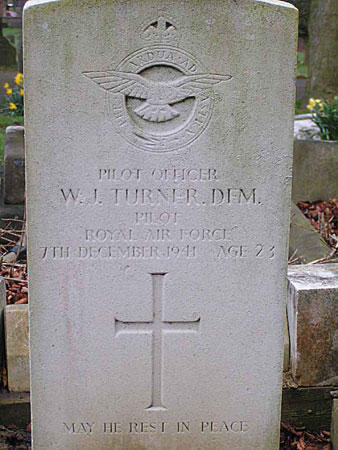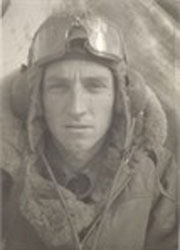Wellington W5535 near Yapham, Pocklington.
On 31st August 1941 the crew of this 405 Squadron aircraft had just taken off from Pocklington to carry out a evening flying training exercise, believed to have been
a basic circuits and landings exercise. The first three named airmen below are the only names given in Bill Chorley's losses book for this incident, however,
the observer named was also flying in the aircraft incase of enemy air activity resulted in them having to divert to another airfield. Given the observer was
flying for this reason it seems likely that they also carried a rear gunner to protect themselves but no evidence of this being fact has been found when this
webpage was last updated. Soon after taking off the port engine caught fire at 350 feet high and the fire spread to the port wing. At 21.50hrs the aircraft
crashed near Yapham, before the fire took a hold of the fuselage the crew were able to scramble clear but the observer's parachute harness caught on something
at the edge of the escape hatch and as he jumped down the harness snagged and he was left hanging upside down having banged his head on the side of the aircraft.
One of the pilots returned to help him down and the aircraft was eventually destroyed by fire. The observer broke his nose and suffered concussion, the rest of
the crew are recorded elsewhere as escaping from serious injury however one of the pilots must have sustained more serious injuries as he was released from the
RAF in the months that followed.
Wellington W5535 was built to contract B.71441/40 by Vickers Armstrong's Ltd. at Weybridge and was awaiting collection in May 1941. It was received by 9 MU on 16th May 1941 and was taken on charge by 405 Squadron at Driffield on 5th June 1941. On 20th June 1941 the aircraft moved to Pocklington with the squadron and as a result of this incident near
Yapham on 31th August 1941 Cat.E2/FA Burnt damage was recorded on the paperwork.
Pilot - Sgt William Joseph Turner RAFVR (708588).
Pilot? - Sgt H S McNeil.
Pilot? - Sgt A N McLennan RCAF (R/65477).
Observer - Sgt Leo James Justin Hanley RAAF (406045).
Possible Air Gunner - Name unknown.
The photograph of his grave was found on the internet and made available by Mr Gordon Hartley, initially for use in the "Cotton Town digitisation project"
website found at www.cottontown.org.
I thank Mr John Hanley for contacting me in August 2013 and for supplying his father's name to this record, and for much of the account given about the
incident at Yapham. Leo Hanley's story is a facinating one. Prior to his son's contact just the three pilots were previously recorded on this webpage (or for
that matter anywhere else on the internet listing Wellington W5535). Mr Hanley's father survived the incident to Wellington W5535 at Yapham and was in hospital
for four days and took three weeks before he returned to flying duties. Leo Hanley was born in 12th March 1916 in Perth and was working as a salesman when he
enlisted into the RAAF on 25th May 1940 also in Perth. After completing basic training he was posted to the UK where he trained at 10 OTU begining on 24th May
1941. He was posted to 405 Squadron on 28th August 1941 (just three days before the incident at Yapham) and would fly three operational flights with 405 Squadron
with his pilot being Sgt John Leeuwin-Clark RAAF (402225). Two of these operational flights were on 21st September 1941 to Ostend and on 19th September 1941
to Hamburg. Leo Hanley and Leeuwin-Clark were later posted to the Overseas Delivery Unit and were tasked with flying a Wellington out to the Middle East.
He and Leeuwin-Clark were among the crew of Wellington X9948 which left Harwell airfield on 24th October 1941 with the final destination being the Middle
East theatre, the aircraft was flown on a number of staging flights over a period of a few days, from Harwell to Gibraltar and then to Malta. Having left Luqa
airfield, Malta at 00.44hrs on 1st November 1941 the aircraft landed safely in North Africa, he was then posted to 148 Squadron. The RAF had no record of the
Wellington landing in North Africa so the aircraft and its crew were posted as missing, Leo Hanley had been flying operationally in North Africa for six weeks
before the error was spotted. An administrative error had resulted in telegrams being sent by the RAF/RAAF to his parents and wife stating that Leo was missing.
His father then informed the RAAF that his son had been seen by people who knew him in Cairo in the days after 1st November 1941. The RAF/RAAF then informed them
that he was a PoW before actually correcting the records and informing his family that he was actually safe and well and not a PoW. It seems hard to believe
that such a shocking error could have occurred.
After this ineptness by those in charge Leo quite understandably was not too impressed by the way he was treated and informed those in charge of him of
this and requested to be taken off flying Wellingtons. He should probably have had a Court Martial in North Africa but there were no RAAF officers available
to form a panel so he escaped this. His RAAF service record records after this that he was a "waverer" and had lost his nerve flying in Wellingtons. This was
probably to cover their own backs, on his service record it states that he was posted back to Australia in Summer 1942 but this was not the case as the RAF
refused to allow him to return home. He was infact kept in North Africa until November 1944, he took a position driving a RAAF priest around North Africa
identifying battlefield burials and other important work that was eventually used by the Commonwealth War Graves Commission and resulted in many battlefield
burials being re-located, the casualties exhumed and many buried in large military plots after the War. He did eventually return home where he died in 1989. This role was a more that worthy alternative to being aircrew in my mind.
I also list the name of AC1 Keith Mervyn Ward RAFVR (1121014) who died on this date, he was aged twenty and was a Pocklington lad, he is buried in
Pocklington Burial Ground, Yorkshire. He died as a result of enemy action at Holme on Spalding Moor airfield. The enemy action injured at least seven ground crew members and a female NAAFI civilian.
William Turner was probably acting as an instructor when Wellington Z5535 crashed, he had flown operationally with 405 Squadron on many of their
flights in August 1941. He was awarded the DFM (Gazetted on 21st October 1941) (although his service number varies on the London Gazette between
708588 (on his DFM) and 758088 for his later commission)) after completing a Tour with 405 Squadron, although no citation has yet been found. He was
then posted to 22 OTU and commissioned on 17th November 1941. On 7th December 1941 he was killed when Wellington T2566 crashed on take off from
Wellesbourne Mountford. He was twenty three years old and is buried in Blackburn Cemetery, Lancashire.

The other two pilots had both flown operationally as second pilots in the weeks before this accident at Yapham. Sgt McLennan was posted in to 405 Squadron
on 14th July 1941 and had flown operationally with 405 Squadron as a second pilot on 12th August 1941 to bomb Berlin in Wellington "L" and two days later in
the same aircraft to bomb Magdeburg and in "D" on 19th August 1941 to Kiel on 22nd August to Mannheim (all with F/Lt McCormack as captain). Sgt McNeil had
flown operationally with 405 Squadron as a second pilot on 14th August 1941 to Madgeburg in "S" and in the same aircraft to Cologne two days later, he then
flew to Kiel on 19th August also in "S" with Sgt Farnborough as his captain.
